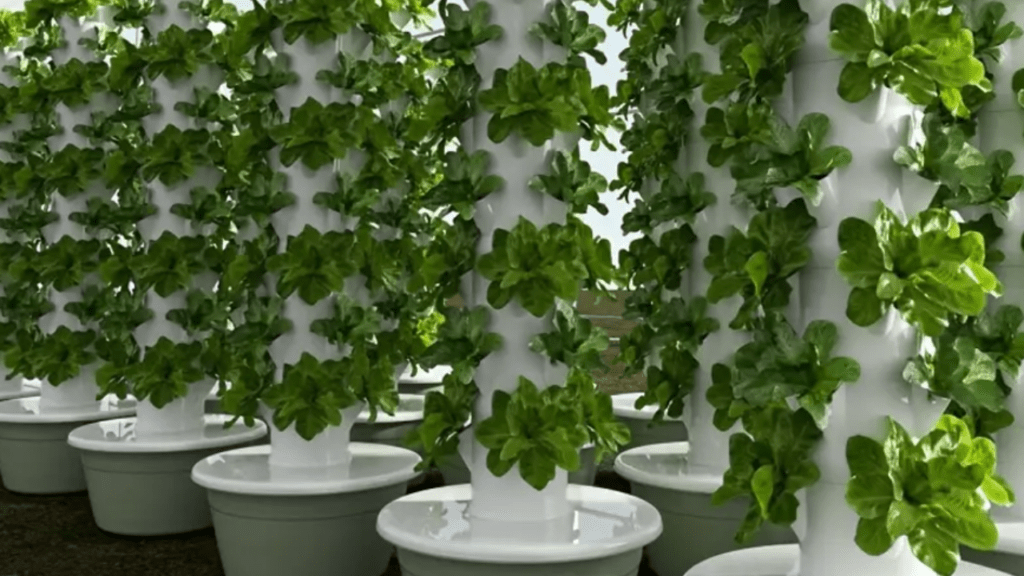
Planting Tower: How to Maximize Your Garden Space Efficiently
If you’re looking to make the most out of your garden space, planting towers can be a game-changer. In this post, we’ll delve into the concept of planting towers and how they can help you maximize your garden space efficiently. We’ll provide tips and techniques for setting up and using planting towers to get the most out of your garden. Whether you’re a seasoned gardener or just starting out, this post will help you make the most of your gardening space.
Table of Contents
ToggleWhat is a Planting Tower?
Definition and Overview: Explain what a planting tower is, including its structure and how it works.
A planting tower is a vertical gardening structure that allows you to grow a variety of plants in a small space. It typically consists of stacked tiers or shelves that can hold individual plant pots or pockets. The structure is usually made of sturdy, weather-resistant materials such as plastic, metal, or wood. Planting towers are designed to maximize vertical space and provide an efficient way to grow vegetables, herbs, flowers, and other plants.
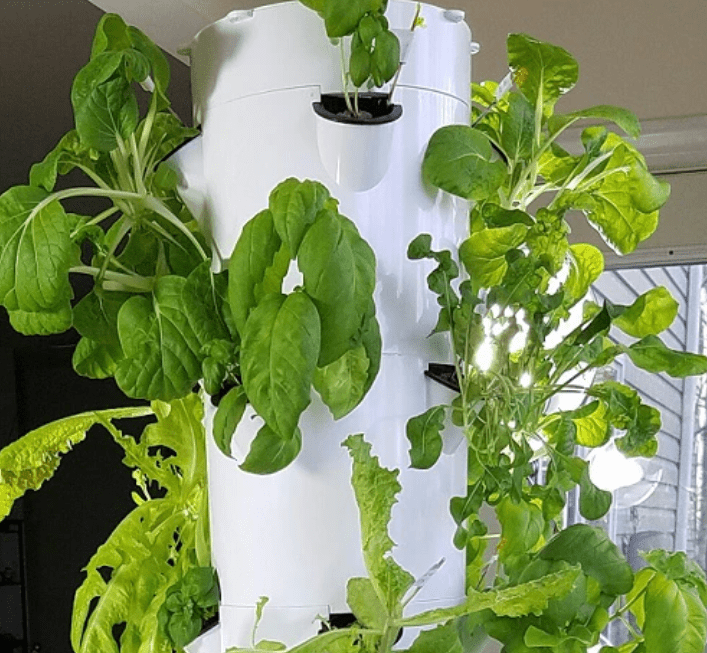
How It Works:
Planting towers work by utilizing vertical space to grow plants, making them ideal for small gardens, patios, balconies, or even indoor spaces. The tiers or shelves of the tower provide ample room for planting, and the structure allows for proper drainage and air circulation. Some planting towers also come with built-in watering systems to ensure that plants receive the right amount of water and nutrients. This vertical gardening approach can help you grow more plants in a smaller area while also providing better access for maintenance and harvesting.
In conclusion, planting towers are an efficient and space-saving way to grow a variety of plants. Whether you’re limited on garden space or simply want to maximize your growing area, a planting tower can be a valuable addition to your gardening setup. With the right planning and care, you can create a thriving garden using this innovative vertical gardening technique.
Types of Planting Towers:
Vertical Garden Towers: Discuss towers designed for growing a variety of plants vertically.
Vertical Garden Towers are a great way to maximize growing space and cultivate a variety of plants in a vertical manner. These towers are designed to provide ample room for planting, allowing you to grow more plants in a smaller area. The structure of the towers also ensures proper drainage and air circulation for the plants, and some even come with built-in watering systems to ensure that the plants receive the right amount of water and nutrients. This vertical gardening approach is ideal for small gardens, patios, balconies, or even indoor spaces, and it can help you create a thriving garden while saving space. There are different types of planting towers available, each offering unique features and benefits to suit your gardening needs. Whether you’re limited on garden space or simply want to make the most of your growing area, a planting tower can be a valuable addition to your gardening setup. It’s an efficient and space-saving way to grow a variety of plants, and with the right planning and care, you can create a beautiful and productive garden using this innovative vertical gardening technique.
Strawberry Towers: Specially designed for strawberries and similar plants.
Vertical Garden Towers are a specially designed structure that allows you to grow strawberries and similar plants in a vertical manner. These towers are an efficient and space-saving way to maximize growing space and cultivate a variety of plants. The structure of the towers ensures proper drainage and air circulation for the plants, and some even come with built-in watering systems to ensure that the plants receive the right amount of water and nutrients. This vertical gardening approach is ideal for small gardens, patios, balconies, or even indoor spaces, and it can help you create a thriving garden while saving space. There are different types of planting towers available, each offering unique features and benefits to suit your gardening needs. Whether you’re limited on garden space or simply want to make the most of your growing area, a planting tower can be a valuable addition to your gardening setup. With the right planning and care, you can create a beautiful and productive garden using this innovative vertical gardening technique.
Herb Towers: Ideal for growing a variety of herbs in a compact space.
Vertical Garden Towers, also known as Herb Towers, are an ideal solution for growing a variety of herbs in a compact space. These specially designed structures allow you to maximize your growing space by growing herbs in a vertical manner. Whether you have a small garden, patio, balcony, or even indoor space, herb towers are an efficient and space-saving way to cultivate a thriving herb garden.
The structure of the towers ensures proper drainage and air circulation for the plants, which is essential for healthy plant growth. Some herb towers even come with built-in watering systems to ensure that the plants receive the right amount of water and nutrients, making it easier for you to maintain your herb garden.
There are different types of herb towers available, each offering unique features and benefits to suit your gardening needs. With the right planning and care, you can create a beautiful and productive herb garden using this innovative vertical gardening technique. So if you’re looking to grow a variety of herbs in a limited space, consider using herb towers to make the most of your growing area.
Benefits of Using a Planting Tower
Maximizing Garden Space: How a planting tower allows you to grow more plants in a smaller area.
Planting towers are a great way to maximize your garden space and grow more plants in a smaller area. These specially designed structures allow you to grow herbs in a vertical manner, making them perfect for small gardens, patios, balconies, or even indoor spaces. The vertical design of the towers ensures that you can cultivate a thriving herb garden without taking up too much space. Additionally, the structure of the towers provides proper drainage and air circulation for the plants, essential for healthy plant growth.
Some planting towers even come with built-in watering systems, making it easier for you to maintain your herb garden and ensure that the plants receive the right amount of water and nutrients. With different types of herb towers available, each offering unique features and benefits, you can choose the one that best suits your gardening needs and preferences. With the right planning and care, you can create a beautiful and productive herb garden using this innovative vertical gardening technique.
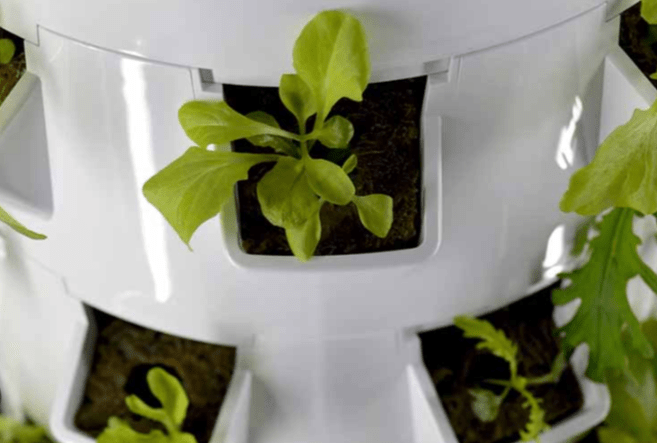
So if you’re looking to grow a variety of herbs in a limited space, consider using a planting tower to make the most of your growing area. It’s a space-saving and efficient way to cultivate a healthy and diverse herb garden.
Ease of Access: Discuss how planting towers make gardening more accessible, reducing the need for bending or kneeling.
Planting towers are a great option for anyone looking to start a garden or expand their current gardening space. The vertical design of the towers makes gardening more accessible, reducing the need for bending or kneeling. This is beneficial for those with physical limitations or anyone who wants to make gardening easier on their body. With planting towers, you can cultivate a thriving herb garden without taking up too much space. The structure of the towers provides proper drainage and air circulation for the plants, essential for healthy plant growth. Some planting towers even come with built-in watering systems, making it easier to maintain your herb garden and ensure that the plants receive the right amount of water and nutrients. With different types of herb towers available, each offering unique features and benefits, you can choose the one that best suits your gardening needs and preferences. Whether you’re a beginner or an experienced gardener, planting towers are a convenient and efficient way to grow a variety of herbs in a limited space. It’s a great option for anyone looking to create a beautiful and productive herb garden.
Enhanced Aesthetics: How planting towers can add vertical interest and beauty to a garden.
Planting towers are a great way to add vertical interest and beauty to a garden. They provide a unique and visually appealing way to display your plants, creating a striking focal point in your outdoor space. Whether you have a small garden or a large one, planting towers can help maximize your growing space and add a touch of creativity to your landscape. These towers can be a great option for those with physical limitations or anyone who wants to make gardening easier on their body. With planting towers, you can cultivate a thriving herb garden without taking up too much space. The structure of the towers provides proper drainage and air circulation for the plants, essential for healthy plant growth. Some planting towers even come with built-in watering systems, making it easier to maintain your herb garden and ensure that the plants receive the right amount of water and nutrients. With different types of herb towers available, each offering unique features and benefits, you can choose the one that best suits your gardening needs and preferences. Whether you’re a beginner or an experienced gardener, planting towers are a convenient and efficient way to grow a variety of herbs in a limited space. It’s a great option for anyone looking to create a beautiful and productive herb garden.
Improved Plant Health: Benefits such as better air circulation and reduced risk of soil-borne diseases.
Planting towers are a great way to improve plant health. They provide better air circulation and reduce the risk of soil-borne diseases. These towers are a great option for those with physical limitations or anyone who wants to make gardening easier on their body. With planting towers, you can cultivate a thriving herb garden without taking up too much space. The structure of the towers provides proper drainage and air circulation for the plants, essential for healthy plant growth. Some planting towers even come with built-in watering systems, making it easier to maintain your herb garden and ensure that the plants receive the right amount of water and nutrients. With different types of herb towers available, each offering unique features and benefits, you can choose the one that best suits your gardening needs and preferences. Whether you’re a beginner or an experienced gardener, planting towers are a convenient and efficient way to grow a variety of herbs in a limited space. It’s a great option for anyone looking to create a beautiful and productive herb garden.
How to Maximize Your Garden Space Efficiently with a Planting Tower
Choosing the Right Location
Choosing the right location for your planting tower is crucial for the success of your herb garden. You’ll want to place it in an area that receives plenty of sunlight, as most herbs require at least 6-8 hours of sunlight per day to thrive. Additionally, make sure the location has access to water for easy irrigation of your plants. It’s also important to consider the space around the planting tower, as you’ll need enough room to access and maintain the plants as they grow. By choosing the right location for your planting tower, you can maximize your garden space and create a thriving herb garden with ease.
Selecting Plants for Your Planting Tower
When selecting plants for your planting tower, it’s important to consider the space and sunlight requirements of each herb. Some popular herbs for planting towers include basil, thyme, rosemary, and cilantro. Each of these herbs has different sunlight and water requirements, so make sure to choose plants that will thrive in the location of your planting tower. It’s also a good idea to consider the height and growth habits of the herbs to ensure they will fit well in the vertical space of the planting tower. By carefully selecting the right plants for your planting tower, you can create a beautiful and productive herb garden that maximizes your garden space efficiently.
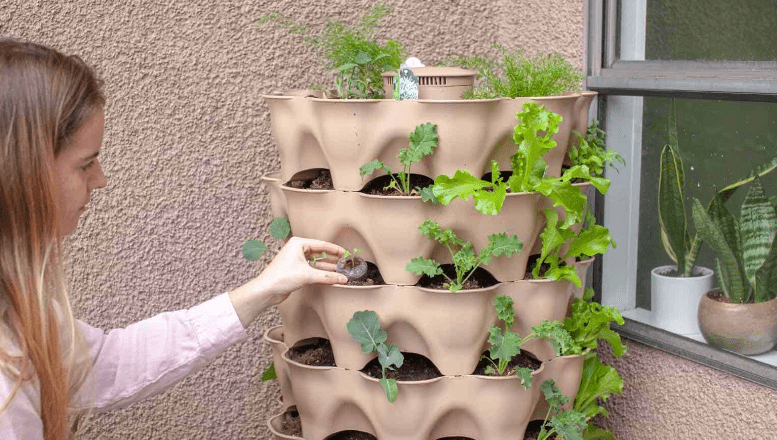
Assembling and Setting Up the Tower
When assembling and setting up the tower, it’s important to ensure that you have a sturdy and stable structure. Follow the instructions carefully and make sure all the components are securely attached. Place the planting tower in a location that receives ample sunlight and is easily accessible for maintenance and harvesting. Consider the space around the tower, as you’ll need room to access and care for the plants as they grow. When selecting plants for your planting tower, consider the sunlight and water requirements of each herb. Popular herbs for planting towers include basil, thyme, rosemary, and cilantro, but make sure to choose plants that will thrive in the specific location of your tower. Consider the height and growth habits of the herbs to ensure they will fit well in the vertical space of the tower. By carefully selecting and placing the right plants for your planting tower, you can create a beautiful and productive herb garden that maximizes your garden space efficiently.
Planting Techniques
When using a planting tower, it’s important to follow the instructions carefully and ensure that all the components are securely attached. The location of the planting tower is also crucial, as it should receive ample sunlight and be easily accessible for maintenance and harvesting. It’s important to consider the space around the tower, as you’ll need room to access and care for the plants as they grow. When selecting plants for your planting tower, consider the sunlight and water requirements of each herb. Popular herbs for planting towers include basil, thyme, rosemary, and cilantro, but make sure to choose plants that will thrive in the specific location of your tower. Consider the height and growth habits of the herbs to ensure they will fit well in the vertical space of the tower. By carefully selecting and placing the right plants for your planting tower, you can create a beautiful and productive herb garden that maximizes your garden space efficiently.
Watering and Maintenance
Are crucial aspects of taking care of your planting tower. It’s important to water your plants regularly, but be mindful not to overwater them. The soil should be moist, but not waterlogged. You can use a watering can or a drip irrigation system to ensure that your plants receive the right amount of water. It’s also important to monitor the health of your plants and check for any signs of pests or diseases. Regular maintenance, such as pruning and removing dead leaves, will help to keep your plants healthy and thriving. Additionally, you should also fertilize your plants occasionally to provide them with the nutrients they need to grow. Taking the time to properly care for your planting tower will ensure that you have a bountiful and beautiful herb garden.
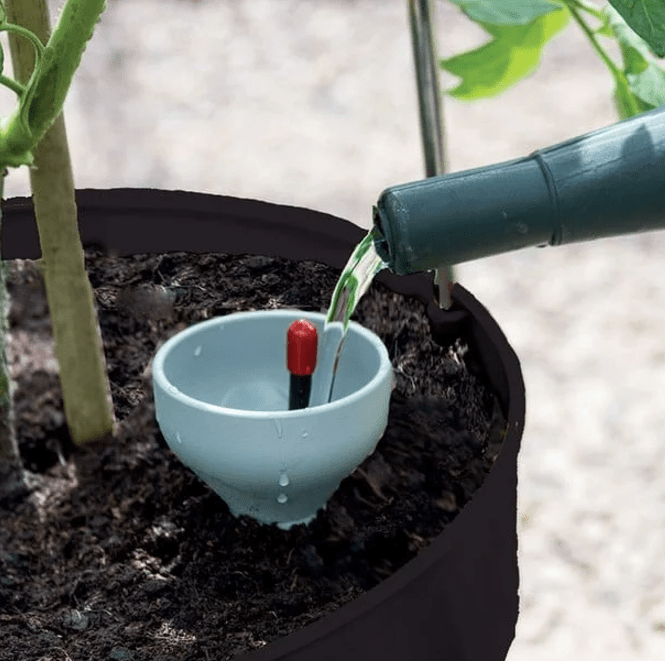
Common Challenges and Solutions
Dealing with Pests: How to manage common pests that may affect your planting tower.
One common challenge when it comes to planting towers is dealing with pests. It’s important to be proactive in managing common pests that may affect your plants. One way to manage pests is to regularly inspect your plants for any signs of infestation. Look for chewed leaves, holes in the leaves, or any visible pests on the plants. If you do notice any pests, you can try using natural remedies such as insecticidal soap or neem oil to control the infestation. Another method is to introduce beneficial insects, such as ladybugs or lacewings, to help control pest populations. Additionally, you can also use physical barriers such as mesh netting to prevent pests from reaching your plants. By taking these proactive measures, you can effectively manage common pests and protect your planting tower from infestations.

Preventing Overcrowding: Tips on avoiding overcrowding and ensuring all plants receive adequate resources.
Overcrowding can be a major issue in gardening, as it can lead to competition for resources among your plants. To avoid overcrowding, it’s important to plan out the spacing of your plants and give them enough room to grow. Make sure to follow the recommended spacing guidelines for each type of plant you are growing. This will ensure that all of your plants have access to adequate sunlight, water, and nutrients. Additionally, regular pruning and thinning of plants can help prevent overcrowding and promote better air circulation. This will not only help prevent disease, but also ensure that all of your plants receive the resources they need to thrive. Lastly, be mindful of the size of each plant at maturity and consider this when planning out your garden layout. By taking these steps, you can prevent overcrowding and ensure the success of your garden.
Water Management: Solutions for preventing waterlogging or dehydration.
Water management is crucial for the success of your garden. To prevent waterlogging, make sure your garden has proper drainage. You can achieve this by adding organic matter to the soil to improve its structure and allow for better water absorption. Avoid overwatering your plants and use mulch to help retain moisture in the soil. On the other hand, to prevent dehydration, it’s important to water your plants consistently and deeply, especially during hot and dry periods. Consider investing in a drip irrigation system to deliver water directly to the roots of your plants. Additionally, choosing drought-resistant plants and incorporating drought-tolerant landscaping techniques can help minimize water usage. By implementing these solutions, you can effectively manage water in your garden and ensure the healthy growth of your plants.
Conclusion
In conclusion, using planting towers is a great way to make the most of limited garden space. By stacking plants vertically, you can grow more in a smaller area. Additionally, planting towers can help protect your plants from pests and diseases, and they make watering and harvesting easier. Whether you have a small backyard or a balcony, planting towers can help you create a lush, productive garden. If you want to learn more about maximizing your garden space efficiently, check out our upcoming workshop on vertical gardening.
Frequently asked questions And Answer
A planting tower is a vertical gardening system that allows you to grow plants in a small space by stacking planting containers on top of each other.
Using a planting tower allows you to maximize your garden space, grow a variety of plants in a small area, and makes it easier to maintain and harvest your crops.
You can grow a variety of plants in a planting tower, including herbs, vegetables, flowers, and even small fruit trees.
Watering and fertilizing a planting tower is done through a drip irrigation system or by hand. The water and fertilizer flow through the top of the tower and trickle down to each level, ensuring that all the plants receive the necessary nutrients.
Yes, planting towers can be used indoors as long as there is enough natural or artificial light for the plants to grow.
Regularly check the water and nutrient levels, prune and harvest plants as needed, and monitor for pests and diseases.
Consider the size of your garden space, the types of plants you want to grow, and your budget when choosing a planting tower.
Yes, planting towers can be a great option for beginner gardeners as they are easy to set up, maintain, and provide a space-saving solution for growing plants.
